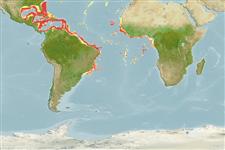Common names from other countries
Classification / Names / Names
Nomi Comuni | Sinonimi | Catalog of Fishes (gen., sp.) | ITIS | CoL | WoRMS
Environment: milieu / climate zone / depth range / distribution range
Ecologia
Associati a barriera corallina; distribuzione batimetrica 1 - 113 m (Ref. 127877). Tropical; 33°N - 25°S, 98°W - 10°E (Ref. 848)
Atlantic Ocean: Bermuda to Brazil and Mexico to Gabon.
Length at first maturity / Size / Peso / Age
Maturity: Lm ? range ? - ? cm
Colonies are massive, forming boulders or domes, or are flat plates. Corallites are variable but are usually conical and exsert. Long and short septa strongly alternate, with alternate septa joined to the columella. Commonly green, brown, grey, or orange.
Zooxanthellate (Refs. 116012, 121684). Found on rocky reef, in shallow to mesophotic waters (Ref. 121684). Common throughout the Caribbean to a depth of 70 m (Ref. 415). In Belize, it was found in a submarine cave near Columbus Cay at a depth of 10 m (Ref. 87209).
Life cycle and mating behavior
Maturità | Riproduzione | Deposizione | Uova | Fecundity | Larve
Mature gametes are shed into the coelenteron and spawned through the mouth. Life cycle: The zygote develops into a planktonic planula larva. Metamorphosis begins with early morphogenesis of tentacles, septa and pharynx before larval settlement on the aboral end (Ref. 833).
Collin, R., M.C. Díaz, J. Norenburg, R.M. Rocha, J.A. Sánchez, M. Schulze, A. Schwartz and A. Valdés. 2005. (Ref. 415)
IUCN Red List Status (Ref. 130435)
CITES status (Ref. 108899)
Not Evaluated
Human uses
| FishSource |
Strumenti
Informazioni ulteriori
Age/SizeAccrescimentoLength-weightLength-lengthMorfologiaLarveAbbondanza
Fonti Internet
Estimates based on models
Preferred temperature
(Ref.
115969): 5.8 - 16.9, mean 10 (based on 269 cells).
Price category
Unknown.
